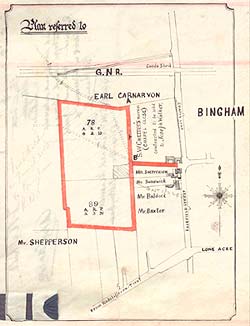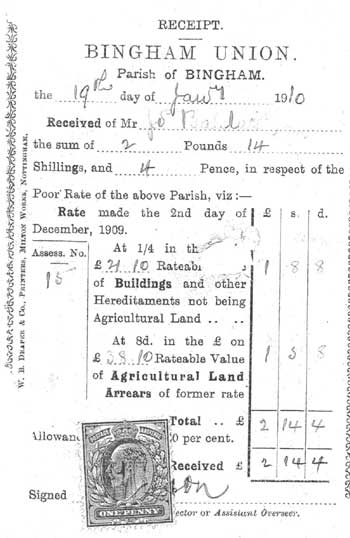![]()
9 School Lane
The house stands on part of what in the early nineteenth century was a ten-acre site attached to the windmill then owned by Thomas Walker. The mill stood where Nos 1 and 3 School Lane are now. School Lane was then known as Mill Lane- presumably until the school was built in 1909.
The ten-acre site was divided into 'closes' of pastureland. Chapel Close, north of the windmill, was later occupied by Kirkland House. 9 School Lane now occupies part of Kirkhill Close, which was made up of two fields totalling seven acres two roods and four perches west of the windmill. In the deeds of Kirkland House, Kirkhill Close is described as being 'previously known as Day Close and latterly (1856) as Mill Close. The 1841 Tithe map shows a second mill on an enclosure named Mill Close, the former grounds of number 9 shown in the plan below. We think this was operated by Robert Wilson who the 1841 & 1851 censuses show as living in Fair Close. See the plan at 15 Fairfield Street.
The chapel of St. Helen, built in 1301 by Richard de Bingham, is thought to have been on this Kirkhill site with its cemetery on Chapel Close.
In 1867 Chapel Close was sold to Samuel Walker Chettle. The earliest (1906) deeds we have for 9 School Lane show that Samuel Walker Chettle also owned Kirkhill Close. He is mentioned in the Kelly's directory of 1888 as being one of the two principal landowners of Bingham, the other being the Earl of Carnarvon.
The documents for 9 School Lane and for Kirkland House record that prior to Chettle's ownership James Oliver occupied both Kirkhill Close and Chapel Close. In the case of Chapel Close he was clearly a tenant during the period when the land was leased as security for a loan. He may well have been a tenant of Kirkhill too and maybe that was also security for a loan at the same time. This we don't know. Oliver's trade is not recorded in either set of deeds, but there was a grocer in the Market Place in 1822, 1829 and 1832 named John Oliver. Joseph Oliver was a wine merchant in 1800 in the Needham’s former house in Long Acre. The loan was from 1832 to 1845.
The deeds for 9 School Lane do not tell us when Chettle bought Kirkhills. Walker's sons Samuel and Thomas are mentioned as millers in the 1853 directory but not in 1864. He clearly owned it at the time of the indentures of 1875 mentioned in the schedule which seem likely to be referring to appointments of trustees to an earlier will than the one mentioned in the deed as drawn up in 1892. The 1875 indentures were between Chettle and his daughter with James Maude and William Miller Oakes. (Oakes transferred his trusteeship to Thomas Richard Hall in 1901.) So Chettle already owned Kirkhills when he bought Chapel Close in 1867.
After Chettle died in 1894 John Strong is recorded as occupying both Kirkhill and Chapel Closes. Chettle's will directed that his properties be held in trust and the rents used for the maintenance and education of his three grandchildren, the offspring of his daughter Elizabeth Ann Hall. These were Edith (b 3.6.1882), Donald (b 24.5.1883) and Constance Mary (b 6.12.1884). The properties were to be sold when the youngest girl reached the age of 21. On 22 January 1901 trusteeship passed to Thomas Richard Hall of Granby, gentlemen, the girls' father.
Thus Kirkhills was sold on 6th October 1906 to Joseph
Baldock, Chapel Close having been sold in June of that year to James Walker
the builder. In the conveyance Baldock is described in the deeds as a
Relieving Officer and of Bingham. In the 1895 directory he is listed as
living in Cropwell Bishop and is described as Relieving Officer to the
Board of Guardians of Bingham Workhouse and Registrar of Births and Deaths.
Another interesting connection now arises between Kirkhill and Chapel
Closes. The Board of Guardians rented and then bought Kirkland House for
use as an orphanage (The Cottage Home) for children from the workhouse.
|
The 1906 deeds plan shows a Mr Baldock as owner of the third plot on Fairfield Street to the south of School Lane. Receipts provided by the present owners show that Joseph Baldock lived at 19 Fairfield Street in 1910. The one shown is for poor law rates and shows he paid for agricultural land as well as his house. That land must have been Kirkhill Close. Eventually in July 1920 Baldock had Nottingham Architects M Hall Sands design him a house that is now number 9 School Lane. It would presumably have been constructed in the last part of 1920. The present owners wonder if the land had been an orchard. The floor and walls of the loft of the garage (presumably a coach house originally) are wooden boarded and would make an excellent dry storage area. |
|
The final part of the story of 9 School Lane is the beginning of the development of Carnarvon Place. In September 1948 Annie Baldock, John Baldock (presumably the son) and Frederick Thomas Stokes (presumably an executor) sold 7 acres to Bingham rural District Council. The hatched area on the plan shows the present extent of the property. Thus some houses on Carnarvon Place now stand on the possible site of a 14th century chapel.


